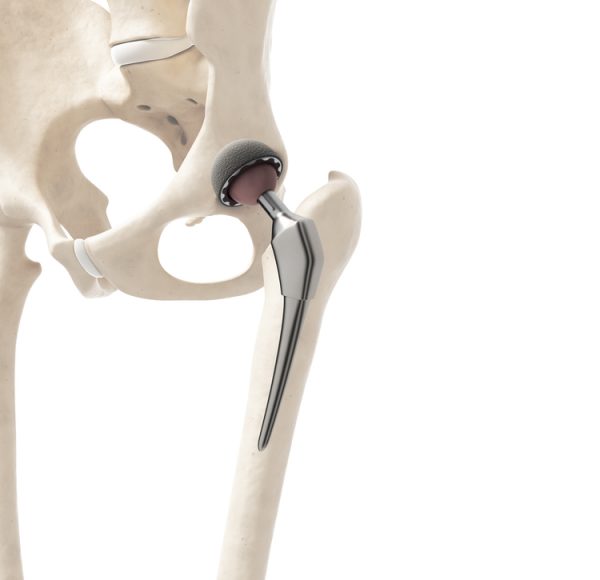What is Total Hip Replacement Surgery?
Total Hip Replacement Surgery in Singapore (THR) is deemed the most successful operation in this century and it is the only reliable and reproducible treatment option for the severely damaged hip joint. It works by replacing a hip with an artificial prosthesis, which helps to restore previous mobility. It is used when all other treatment options like physical therapy, medications, and braces have failed to deliver pain relief.
The damage can occur due to various causes such as Osteoarthritis (OA), Rheumatoid Arthritis (RA), Avascular Necrosis (AVN), Ankylosing Spondylitis (AS), fracture and infection.
Of these, hip arthritis seems to be the biggest culprit for the need for this intervention. The connective tissue of the bones, the cartilage, acts like a cushion preventing the bones from rubbing against each other when in motion. Arthritis is a condition which damages the cartilage in such a way that it is no longer capable of maintaining its normal functions. And this might require surgery to fix.

Who Needs Hip Replacement in Singapore?
The majority of people who undergo this kind of surgery are aged between 50 and 80, but is it not uncommon for youngsters to need hip replacement. Men and women as a young as 19 can be operated on.
The typical signs of a hip joint problem are pain (felt at the groin area or side of the hip joint), stiffness (one will have great difficulty trying to tie their shoelaces or cutting their toe nails), limb shortening, and an abnormal swaying walking pattern.
When these symptoms become so unbearable that they make it difficult to fall asleep or perform normal activities, patients are usually recommended to go under the knife. As surgery carries certain risk of infection and whatnot, people are carefully selected for this procedure to improve their odds of a successful outcome. Hence, smokers and individuals who are susceptible to getting certain diseases are highly ineligible for total hip replacement. Of course, your doctor will take into account other factors as well.
How Does Hip Replacement Surgery Help You?

How Is the New Hip Built?
Normally, the hip joint consists of a ball and socket, the former being the top of the femoral head (the thigh bone). The latter is made of cartilage and bone. When some or all parts of the joint get damaged, it needs to be replaced with an artificial prosthesis, which can be cemented or uncemented.
The difference is that one is mounted to the hip using bone cement (Plexiglas), which ensures faster adhesion and smaller recovery, and the other is textured in such a way that the bone can attach to it over time as it grows. Of course, this means that the healing process is longer.
Most surgeons avoid the cemented option because it can wear and tear faster, causing the joint to come loose and requiring another replacement. Not to mention, the debris left by the material can irritate the nearby tissue or even enter the bloodstream, an act that can be life-threatening, especially if the cement gets to the lungs.
Your new hip will be composed of different parts, each of which plays a different role:
- A metal socket
- A metal rod that will keep the thigh stable
- A ceramic or metal ball that will take the place of the femoral head
- A liner that will enable the ball to move effortlessly inside the socket
No matter which adhesion method you and your doctor choose, the hip will always be made of these segments.
Advanced Medical Technology
It comprises of the acetabular component, femoral stem and the articulating surfaces. The longevity of the implants can further improve with advanced surface technologies such as Ceramic (Biolox®)/highly cross-linked polyethylene.
The accuracy of total hip replacement in Singapore can be further improved with Robotic Surgery (Makoplasty®) .
Patients opting for this technique will undergo a pre-op CT scan of the lower limb, all the important parameters in the lower limb will then be captured and entered into the computer. Next, these data will be merged with the real-life anatomical landmarks of the patient on the surgical table, and the orthopaedic specialist can use this robotic arm to perform the intervention to pin point accuracy.
What You Should Know About the Post-Operative Period
Depending on whether you go for a cemented or an uncemented joint, artificial hip replacement is a surgical procedure that requires you to take weeks off of work. You need to recognise the fact that you will not be able to perform the things that you typically do. That includes reaching for stuff that is above or below your height range, lifting heavy objects, walking long distances, going up and down the stairs, and even taking a shower, to name a few.
This is why it is important to prepare yourself a few days in advance, providing that the surgery is planned of course. Make sure to place everyday items in areas where you don’t have to overexert yourself to reach. Prepare some meals and toss them in the freezer ahead of time so that when you get back home after the operation you don’t have to worry about food. If you live on your own, find someone who can drive you to your physical therapy sessions (there will be some) and pick you up after you are done.
Frequently Asked Questions
Total hip replacement is a surgical procedure where the damaged hip joint is replaced with an artificial joint. There are 3 common ways your surgeon can gain access to the damaged hip joint:-
- Anterior approach (from the front)
- Lateral approach (from the side)
- Posterior approach (from the back)
Direct anterior approach total hip replacement is a minimally invasive surgical technique that allows the surgeon to reach the hip joint from the front by going between the muscles instead of cutting through them, which can result in a quicker recovery and less postoperative pain.
- Faster recovery time
- Less pain after surgery
- Less muscle damage compared to other approaches
- Smaller incision and less scarring
- Improved hip stability
- Facilitate the use of fluoroscopy and computer navigation for accurate components positioning and matching of leg length



The risks are similar to that of conventional total hip replacement.
- Bleeding or blood clots
- Infection
- Fracture
- Hip dislocation
- Nerve or blood vessel damage
- Implant failure or loosening
No. Only conventional prosthesis or parts for total hip replacement are required
Hip replacements in Singapore can cost anywhere between $14,000 to $30,000. The true costs and total expenses depend on several factors such as type of replacement (total or partial), the hospital, type of ward, surgeon opted for, complications management etc.
Contact us today to find out about the costs of hip replacements for your condition.
- Inform your doctor about any medications you are taking, including over-the-counter drugs and supplements.
- Follow the pre-operative instructions provided by your doctor.
- Arrange for someone to drive you home after surgery and help you with daily activities for a few days
- The procedure typically takes 2 hours.
- You will receive general anaesthesia, so you will be asleep during the surgery.
- The surgeon will make a small incision in front of your hip joint and replace the damaged joint with an artificial one.
- You will spend a few days in the hospital before being discharged.
- You may experience some pain and swelling in the hip area, which can be managed with pain medications.
- You will need to use a walker or crutches for a few weeks after surgery.
- You will need to attend physical therapy to regain strength and mobility in the hip joint.
- You should avoid high-impact activities for at least 6-12 weeks after surgery.
- You can resume normal daily activities, such as walking, and light household chores, as soon as you feel comfortable.
- Always follow your doctor's instructions regarding when you can resume specific activities.
In conclusion, Direct Anterior Approach Total Hip Replacement is a minimally invasive surgical technique that can result in a faster recovery and less postoperative pain. However, as with any surgery, it does carry risks. It is important to discuss the benefits and risks of this approach with your doctor to determine if it is the best option for you.


